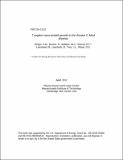Tungsten nano-tendril growth in the Alcator C-Mod divertor
Author(s)
Baldwin, M. J.; Doerner, R. P.; Wright, Graham; Brunner, Daniel Frederic; Labombard, Brian; Lipschultz, Bruce; Terry, James L; Whyte, Dennis G; ... Show more Show less
DownloadWhyte_Tungsten nano-tendril.pdf (5.741Mb)
OPEN_ACCESS_POLICY
Open Access Policy
Creative Commons Attribution-Noncommercial-Share Alike
Terms of use
Metadata
Show full item recordAbstract
Growth of tungsten nano-tendrils ('fuzz') has been observed for the first time in the divertor region of a high-power density tokamak experiment. After 14 consecutive helium L-mode discharges in Alcator C-Mod, the tip of a tungsten Langmuir probe at the outer strike point was fully covered with a layer of nano-tendrils. The thickness of the individual nano-tendrils (50–100 nm) and the depth of the layer (600 ± 150 nm) are consistent with observations from experiments on linear plasma devices. The observation of tungsten fuzz in a tokamak may have important implications for material erosion, dust formation, divertor lifetime and tokamak operations in next-step devices.
Date issued
2012-03Department
Massachusetts Institute of Technology. Department of Nuclear Science and Engineering; Massachusetts Institute of Technology. Plasma Science and Fusion CenterJournal
Nuclear Fusion
Publisher
IOP Publishing
Citation
Wright, G.M. et al. “Tungsten Nano-tendril Growth in the Alcator C-Mod Divertor.” Nuclear Fusion 52.4 (2012): 042003.
Version: Author's final manuscript
ISSN
0029-5515
1741-4326